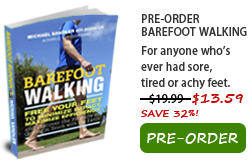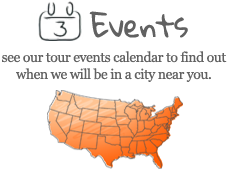The 3 Strides of Barefoot Walking
Does this sound like you? You’ve heard a little about the barefoot movement and its benefits... you want to give it a go... but you’re a bit apprehensive about hitting the sidewalk shodless, so you just don't know where to begin. To make matters more daunting, walking on your forefoot just LOOKS weird. So there you sit, on the proverbial fence, waiting to take that first step.
If this IS you (or someone you know) you are in luck! The good news is that nearly everyone feels this way in the beginning. This is my humble attempt to assuage those fears and enlighten readers on basic barefoot techniques in 800 words or less. Let’s start with aesthetics. You’re right - walking on your forefoot LOOKS weird. But did you know that for centuries Native Americans walked using this stride? And take a closer look at a barefoot toddler walking or running across the room. They’re up on their toes too. Not so strange now, huh? Barefoot walking also helps increase blood flow to the feet (keeping toes toasty) as well as helping them grow stronger and recover quicker. Don’t worry about stubbing your toes or falling. Now that your feet are free of their blindfolds (aka shoes), they can feel the ground and react accordingly before any trip-ups occur.
The most important personal asset to develop for walking (or running) barefoot is strong toes to support arches. When you walk or run on your forefoot, you naturally grab with your toes on the ground. When you walk mid-foot, or on your heel, you tend to relax your toes and your arch collapses downward. The key trick with walking off of the forefoot is we need to grab with our toes in the completion of our stride (more on this below).
Before you attempt any of these strides, find a flat patch of grass or sidewalk to practice on. Hard surfaces are best when starting out as you will naturally strike lighter. As your barefoot training advances, progress to uneven terrain (a trail or hilly field) to further harden core muscles, stabilize muscle groups and strengthen your back. But take it SLOW! By slow I mean starting off with 100 yds – yes, you read that correctly – ONE HUNDRED YARDS. Listen to your body and let your skin be your guide.
Three Basic Barefoot Walking Strides:
Gold: The Forefoot Stride – While it may look strange, this stride has maximum shock absorption. This stride is responsible for relieving countless numbers of runners and walkers of a myriad of injuries and pain. If you can commit to doing this at least part of the time, your body will thank you. The forefoot stride also promotes great posture and core strength, elongating the body and making you naturally taller. Nature’s healing (dynamic) high heel and calf builder! Last but certainly not least, the forefoot stride is great for ninja-inspired maneuvers best employed for midnight cookie stealing.
Silver: The Mid-foot Stride – This stride involves first landing slightly on your forefoot, followed by quickly (almost simultaneously) lightly touching your heel down. This translates to decent shock absorption, though not as effective as forefoot striking. If your calves need a break from the forefoot stride, this is the next best thing. When done properly, you will still walk silently and stealthily with confidence.
Bronze: The Hind-foot Stride – Let’s clarify something first. You don't hit with the heel, in fact, we never HIT anything in a stride. Rather, we gently roll off the heel and quickly onto the toes which then GRAB the ground. Imagine you have claws that grip the ground and pull you forward as you stride. By incorporating this move, you can protect and strengthen the arch and the entire foot. This move cannot be done in a traditional shoe, however it can be done in most minimalist footwear. Keep in mind there is minimal shock absorption with this stride, so it's not as good for your hips, knees and back. But the Hind-foot stride IS how we handled carrying and dragging heavy loads on uneven surfaces for eons. Sometimes a little heel rolling is inevitable, particularly if you're fatigued, pulling or carrying a heavy weight, or hiking on uneven surfaces.
Hopefully this has opened you up to taking that first barefoot step. If you are hungry for more (which we hope you are) stay tuned for Barefoot Walking: The Greatest Exercise on Earth due out this summer. We promise to keep you posted on details! Any questions, comments or blog topic requests, feel free to write at info@RunBare.com.
Run (or Walk) Free!
- Log in to post comments


